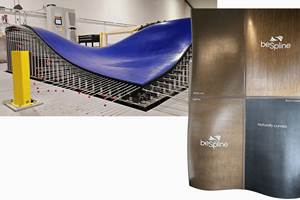Low-rate layup tools made cost-effective with high-density polyurethane foam blocks
Nemesis Air Racing, an air racing team and kit-plane company owned and operated by Jon and Patricia Sharp, use prebonded closed-cell, polyurethane foam blocks to build the Nemesis NXT.
Nemesis Air Racing (Oro Valley, Ariz.) is an air racing team owned and operated by Jon and Patricia Sharp. Formerly a composites engineer at Lockheed Martin Skunk Works (Palmdale, Calif.), Jon Sharp is a legendary air racer: He won the Reno Air Racing National Championships nine consecutive times in a tiny International Formula 1 racing aircraft, dubbed Nemesis, which he and his team developed and fabricated in the early 1990s. The most successful aircraft in air-racing history, the original Nemesis is on display in the Smithsonian National Air and Space Museum (Washington, D.C.). When Sharp decided to build a larger composite racer, the Nemesis NXT, an unexpected rule change mandated that each participating aircraft had to be available for purchase as a kit. Fortunately, the Nemesis name ensured that the required five kits were quickly sold. Sharp and his team were then faced with producing the carbon fiber/epoxy composite kit elements from CAD file data.
Based on his extensive experience at Skunk Works, Sharp understood the benefits of soft tooling for prototyping and limited production: “We were drawn to high-density polyurethane because of the greater level of design flexibility that was available. The inevitable design changes were much less of a headache than with metal tools.”
Coastal Enterprises Co. (Orange, Calif.) supplied Sharp with Precision Board Plus, a 20 lb/ft3, closed-cell, polyurethane foam in customized, prebonded shapes, to create the molds for the NXT’s horizontal and vertical tail, leading edges, interior components and the craft’s 90-gal gas tank. The prebonded shapes saved time and labor during CNC-machining with standard cutting tools, because less material had to be machined to achieve the final mold shapes. As Sharp told Coastal Enterprises, “The foam molds gave us our most accurate airframe ever produced. The tight cell structure and ease of machining enabled us to bring our first computer-designed aircraft to life.”
“If you make the decision to buy metal tooling, you’re constrained by a lot of factors — higher cost, size and weight and overall lead time for the tool build,” contends Coastal Enterprises president Chuck Miller. “High-density urethane foam offers much more flexibility and speed, and the coefficient of thermal expansion can be easily compensated for.” Precision Board Plus reportedly is suitable for tooling applications up to 300°F/149°C, is available in densities from 4 lb/ft3 up to 75 lb/ft3, and can be autoclave-cured, says Miller. He also explains that Coastal’s ability to bond polyurethane foam blocks together in the approximate shape of a final tool (see photo, lower left) prevents bondline voids, which can cause “chunking” of the material during machining (custom mandrels in any size are also on offer): “We formulate our own EP76 epoxy adhesive to match the density of the material,” says Miller, “which helps reduce collet chatter witness lines in the part.”
Miller adds that, in the past, polyurethane foam tools earned a reputation for “inhibiting cure” of carbon/epoxy prepregs due to its out-gassing during heating. In fact, he says, this inhibition of cure can also occur due to out-gassing of some tool sealers. Any out-gassing from the tool during heating, whether it originates from the tooling board, or any sealer, filler, or etc., can react with the epoxy resin and inhibit the composite cure. "Precision Board Plus, in both PBLT 200ºF and PBHT 300ºF formulations, have proven over the years they do not out-gas, contends Miller. "All high-density urethane tooling boards are a fairly good insulator and, therefore, not a good heat conductor and so do not readily conduct temperature." They need time for temperature change (i.e., ramping time, for temperature absorption or release). The typical temperature ramping time for high-density urethane is two minutes per degree Fahrenheit, going up in temperature, and one minute per degree Fahrenheit coming down. "Ramping both directions is critical to allow the CTE expansion and contraction to normalize without causing stress risers and possible cracking. This also allows some extra time for complete layup cure," he notes, adding, "It is always recommended to discuss specific composite applications with the manufacturer prior to layup."
Related Content
Plant tour: BeSpline/Addcomp, Sherbrooke, QC, Canada
Composites automation specialist increases access to next-gen technologies, including novel AFP systems and unique 3D parts using adaptive molds.
Read MoreTroubleshooting thermoplastic composite stamp forming
Understand the basic science of TPC stamp forming, a manufacturing process steadily gaining momentum in aerospace and mobility applications thanks to its rapid forming, short cycle times and automated methods.
Read MoreCorebon induction heating
This sidebar to CW’s August 2024 feature article reviews this technology for more efficient composites manufacturing and why it aligns with Koridion active core molding.
Read MoreNorco GFRP molds meet high-quality cast concrete beam production needs
A project with P&M successfully achieved manufacture of six 20-meter-long architectural beams for an R&D facility with near-seamless surfaces and on a tight production schedule.
Read MoreRead Next
Cutting 100 pounds, certification time for the X-59 nose cone
Swift Engineering used HyperX software to remove 100 pounds from 38-foot graphite/epoxy cored nose cone for X-59 supersonic aircraft.
Read MoreCeramic matrix composites: Faster, cheaper, higher temperature
New players proliferate, increasing CMC materials and manufacturing capacity, novel processes and automation to meet demand for higher part volumes and performance.
Read MoreScaling up, optimizing the flax fiber composite camper
Greenlander’s Sherpa RV cab, which is largely constructed from flax fiber/bio-epoxy sandwich panels, nears commercial production readiness and next-generation scale-up.
Read More












